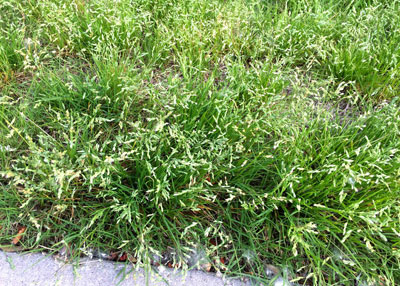Herbicidal Help!

The questions sound like these seven below…
• “Neil, my lawn is all weeds. What can I do?”
• “Neil, what is this weed, and what will kill it?”
• “Neil, is it too late for pre-emergents?”
• “Neil, can I use that weed-and-feed now?”
• “Neil, will weedkillers hurt my dog?”
• “Neil, I applied pre-emergents when you said to in March, and I still have these weeds. Why?”
• “Neil, what can I use to kill this little grass with all the seedheads?”
• “Neil. Neil! Neil!!!”
Don’t get me wrong. I love what I’ve gotten to do for a living, and I look forward to doing it for a long time to come. But, oh my goodness there have been a lot of weed questions recently. So let me just jot down some stream-of-consciousness thoughts that should cover most of the questions and concerns.
1. If your lawn is all weeds, then you need to ramp up your lawn management program. The best way to beat back the weeds is by keeping your lawn vigorous in the first place. There is lots of good information online from southern universities and Extension agencies. If you have my latest book (see my opening remarks here), I spent a month writing the Lawn chapter in it. I give updates each week here in e-gardens. So help is available.
2. You don’t have to identify every last weed by name in order to be able to find the best control for it. You only have to be able to answer these three pairs of questions:
A. Is it annual or perennial?
B. Does it grow in the summer (“warm-season” weed) or in the winter/spring (“cool-season” weed)?
C. Is it a grass or is it a broadleafed plant?
If you can answer those three questions, your local nursery professional can show you the correct herbicide for your job.
1. Pre-emergent weedkillers – for summertime weeds crabgrass and grassburs – must be applied a couple of weeks prior to the average date of the last killing freeze in your area and then repeated 90 days later. Yes, you’re too late in all areas of Texas for these weeds this year. And the application for the winter weeds comes the last week of August or the first week of September. That’s for all of Texas. Timing is critical and non-negotiable!
2. I’m not an advocate of “weed-and-feed” products. I certainly believe in weedkillers, and you’ll hear me recommending fertilizers frequently. You just won’t hear me recommending application of them at the same time. It’s often best, for example, to apply your fertilizer first, water it in deeply, then wait a week for the weeds to start growing actively before you apply the weedkiller. Plus, applying many types of weedkillers over the entire lawn surface risks doing harm to valuable shade trees and shrubs that share the same soil. It’s better, I feel, to do the best possible job of each task, and at separate times.
3. As for whether weedkillers will hurt dogs and other pets, you have to know that one of the first things manufacturers work to prove is that their products will do no harm to people or pets when used according to label directions. Plus, I’m not going to recommend any control that I think might harm animals. I have pets myself.
4. If you applied pre-emergents in March and are seeing weeds now, you’re almost assuredly seeing weeds that germinated in the fall or winter and that are maturing at this time. Summer weeds have barely started growing. I’ve probably heard this 100 times in the past several weeks, and 100 percent of the times when samples or photos have come to me, they’ve been cool-season weeds that could have been prevented by an early September application of a pre-emergent, but not by the March treatment. Go back to those three questions you have to answer in my notes up above.

5. The little grass with all the seedheads is annual bluegrass, or Poa annua. It has just about run its course for this season. It will begin to dry up and die as it turns warm. Your only means of dealing with it is to prevent it by applying pre-emergent granules around September 1. I will tell you at least three or four times about that here in e-gardens, just as I have for the past 17 years. Just as I do in Chapter 2 of my newest book (see it here in my opening remarks). And just as I will do on the radio, just as I’ve done for the past 42 years. Once annual bluegrass starts growing in fall, you have no second chance.
Hopefully that addresses the questions about spring weeds in your lawn. And hopefully it relieves a bit of the angst. You can do this, team! Take a deep breath, and take it one weed at a time.
